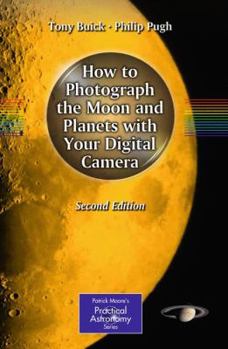How to Photograph the Moon and Planets with Your Digital Camera
Select Format
Select Condition 
Book Overview
Although astronomical CCD cameras can be very costly, digital cameras - the kind you use on holiday - on the other hand, are relatively inexpensive. Moreover, their technology - especially thermal noise, sensitivity (ISO number) and resolution - has progressed to a point where such cameras are more than capable of photographing the brighter astronomical objects. Now Tony Buick has teamed up with fellow author and astro imager Phil Pugh, to produce a completely revised, updated, and extended second edition to How to Photograph the Moon and Planets with your Digital Camera, first published in 2006. The revisions take into account changing (and improving) camera technology, and some items which are now available commercially but which previously had to be home-made. The section of solar observing has been expanded to include observing by H-alpha light, and among the many additional sections are photographing the constellations, aurorae, and basic post-imaging processing.
Format:Paperback
Language:English
ISBN:1441958274
ISBN13:9781441958273
Release Date:January 2011
Publisher:Springer
Length:346 Pages
Weight:1.65 lbs.
Dimensions:0.9" x 6.1" x 9.0"
Customer Reviews
2 ratings
Ticket to the Moon
Published by Thriftbooks.com User , 18 years ago
I was so pleased to know that such a book as this was available to help amateur astronomers new to astrophotography. I am now enjoying the easy to read introductions to each sky target and using the simple but necessary instructions to make the photography possible. Also very pleasing is that the superb images illustrated can be very closely matched by my efforts after reading this book. How refreshing not to have to wade through off-putting text and theory in order to capture beautiful pictures immediately with readily available and inexpensive equipment. I thoroughly recommend this work to anyone eager to begin taking sky pictures, especially of the Moon.
A practical guide to astrophotography on a shoestring
Published by Thriftbooks.com User , 18 years ago
This book shows that you don't need to spend thousands of dollars to be able to take pictures of astronomical objects. The book is an encouragement to amateur astronomers or someone with only a passing interest in the night sky, to go out and take photographs of the the Moon and planets. It shows how anyone can take an astronomical photo with a family digital camera and a little ingenuity and imagination. The book also doubles as a photographic atlas to the Moon with detailed notes on what can be seen in the photographs. I would recommend this book to anyone with an interest in the night sky or photography.





